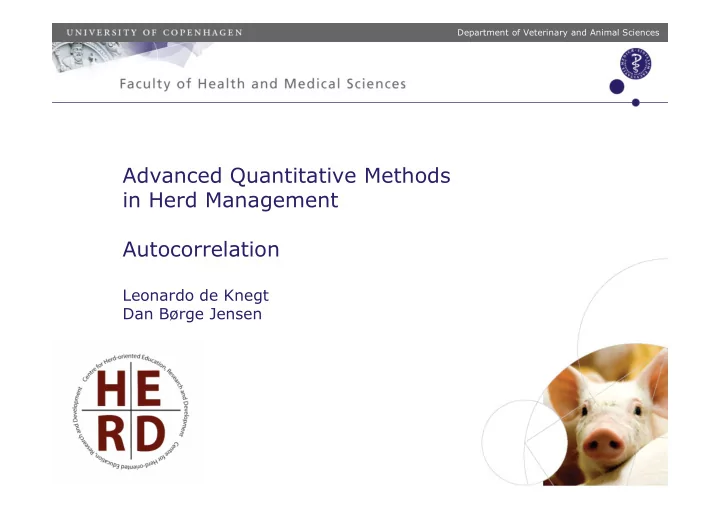

Department of Veterinary and Animal Sciences Advanced Quantitative Methods in Herd Management Autocorrelation Leonardo de Knegt Dan Børge Jensen
Department of Veterinary and Animal Sciences Outline Definition Non-autocorrelated data Autocorrelated data with no trend Autocorrelated data with simple trend Autocorrelated data with systematic trend (seasonality) Real examples in herd monitoring Slide 2
Department of Veterinary and Animal Sciences Definition Milk yield on day 1 more similar to day 2 or day 250 ? • If milk yield t is more similar to milk yield t+1 or milk yield t-1 • than to milk yield t+1+n , the data is said to be autocorrelated. “The degree of correlation between values of the same variables across different observations in the data” Slide 3
Department of Veterinary and Animal Sciences Definition Just as correlation measures the linear relationship • between two variables, autocorrelation measures the linear relationship between lagged values of a time series. Most often discussed in the context of time series data • Same animal/object/herd observed at different • times Slide 4
Department of Veterinary and Animal Sciences Definition Autocorrelation coefficients measures the relationship between y t and y t−k , where k is the length of the lag. � � ∑ � �� � � � � ��� ��� � � � � ����� � ∑ � � � � �� � � � ��� , where T is the length of the time series. Slide 5
Department of Veterinary and Animal Sciences Non-autocorrelated versus correlated Examples in R Slide 6
Department of Veterinary and Animal Sciences Trend and seasonality For data with simple, non-systematic trend • autocorrelations for small lags are large and positive • because observations nearby in time are also nearby in size. the ACF of trended time series tend to have positive • values that slowly decrease as the lags increase. You can reduce correlation using filters (EWMA) • For seasonal data (systematic trend) • autocorrelations are larger for the seasonal lags • e.g. 24 hours for pigs drinking behavior • Shewart on raw data and on forecast errors both useless • For data both trended and seasonal, you see a combination of • these effects. Slide 7
Recommend
More recommend